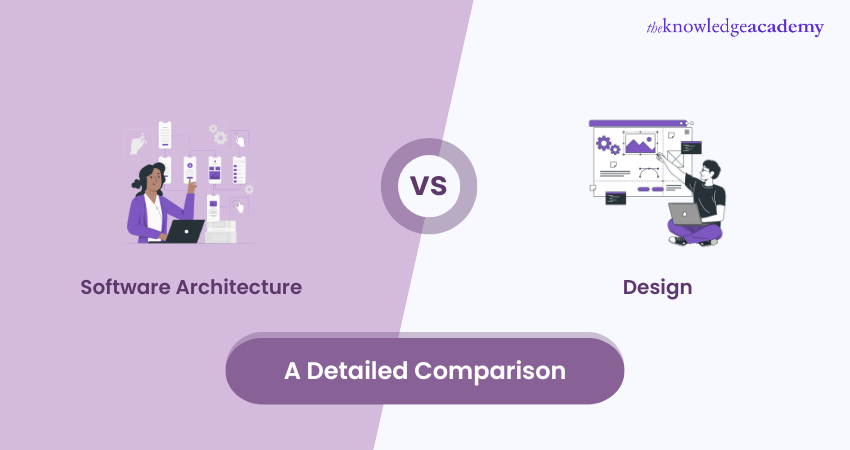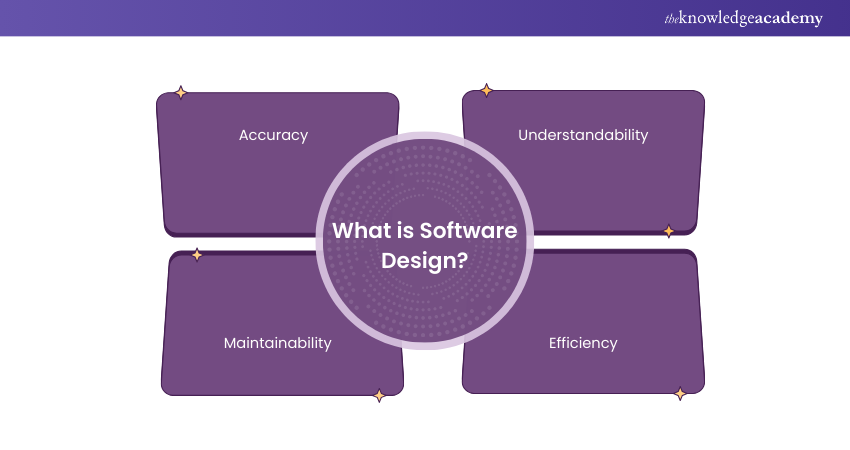We may not have the course you’re looking for. If you enquire or give us a call on +44 1344 203999 and speak to our training experts, we may still be able to help with your training requirements.
Training Outcomes Within Your Budget!
We ensure quality, budget-alignment, and timely delivery by our expert instructors.

Building software is complicated. The process requires many different components. Among that, Software Architecture and Design are two major parts for the development process. For different reasons, these two critical layers of software are often confused with each other.
At times, it really does get hard to tell them apart. However, the basic differences do set them apart. Software Design deals with individual modules and components of the software. Softwrae Architecture, on the other hand, is about the overall structure where all the components fit into.
Table of Contents
1) What is Software Architecture?
a) Key features of Software Architecture
2) What is Software Design?
a) Key features of Software Design
3) Difference between Software Architecture and Design
4) Conclusion
What is Software Architecture?
Software architecture can be defined as the process of translating software characteristics into a structured solution. This framework needs to match business and technical requirements. The key traits of Software Architecture are scalability, flexibility, security and reusability.
It focuses on creating a skeleton and a high end infrastructure of the software. Architecture of a software includes documentation, diagrams, charts, tools used to facilitate communications with stakeholders.
Key features of Software Architecture
The characteristics of the architecture state the requirements of the software and what it is expected to perform. Here, the solution is structured in a specific way The key features of Software Architecture are:
1) Description of fundamental elements: Software Architecture is defined by the core set of elements and other properties required to build the software. It identifies the structure that is necessary to build the software’s core processing.
2) Description of fundamental elements: For making it easier for the stakeholders to understand, creating a visual representation with charts and diagrams is crucial. This provides a detailed insight into the architecture and gain a perspective in order to analyse the structure. With the point of view in line, it becomes easier to pick areas of improvement.
3) Description of high level structure: Development team will need to make decisions about high-level structure. This includes elements like system availability, scaling ability, reliability of system, performance, faults, and configuration and support.
4) Description of what is getting built: Building a software is to primarily meet the needs of stakeholders. However, it not always possible to meet the requirements that they ask for. Therefore, a description of what is being built can help manage expectations. Using flowcharts, diagrams and other supporting documents to keep stakeholders informed is important.
What is Software Design?
Software Design is about building a design plan that dig in for different components which actually builds up the software system. This primarily portrays how they work in union to fulfil all system requirements. Developing a design plan allows setting expectations for customers or end-users or stakeholders. Along with that, it even allows negotiating system requirements when necessary.
Software Design stage comes after certain steps, including:
1) Domain analysis
2) Risk analysis
3) Requirement analysis
A design plan offers a valuable point of reference for the further development process. It almost works as a blueprint with guidelines for the team. This guide includes details such as coding, integration, and testing.
Its aim is to help developers transform requirements into proper implementation and execution. Thus, certain artifacts are expected to be produced by the Software Design process, such as:
1) High-level design: A high-level design provides a more specific view of subsystems, modules and components of the system design. It focuses on how the modules is implemented with the system and how they are complementing with each other.
2)Software requirements: It describes the expected behaviour of the system during any kind of interaction with other systems, hardware or users – in the functional and non-functional requirements. These requirements should be measurable, actionable and traceable.
3) In-depth and detailed design: This also generates a detailed system design that fishes for the bugs of implementing modules. It becomes very helpful for the development team as it defines logical structure of all the modules and its interfaces.

Key features of Software Design
In order to create a high-end software system, it is essential to make a design that does not compromise on quality. High quality designs have some common characteristics, which are listed down:
1) Accuracy: the design produced needs to be correct. This is essential as identifying and implementing components as the software requirements is dependent on accuracy.
2) Understandability: A design that is easily understandable, makes the process easier for the developers. The design should be self explanatory and as clear as possible. If you need to spend a lot of time for verbal explanation about what needs to be done, then the design needs more work. It at times, may also work as a hindrance in the development process.
3) Maintainability: The design should be able to go through alterations when need be. Therefore, it needs to be very easy to maintain. The design should be stored at an accessible location as well, so that team members can analyse whatever changes has been made.
4) Efficiency: If the design is not being able to describe the software to be efficient, then it has little to no value for the customers and their expectations.
Elevate your software and tech knowledge with our Software Engineering Course – sign up now!
Difference between Software Architecture and Design
Often confused with one another, Software architecture and Software Design are inherently different. This confusion leads to misunderstandings which can put the development process at risk. Let's walk through the differences:
|
Sl.No. |
Software Architecture |
Software Design |
|
1 |
It is about designing individual components or modules. |
It is about the complete structure of the overall system. |
|
2 |
It tries to avoid uncertainty. |
It manages uncertainty. |
|
3 |
It helps to implement software. |
It helps defining high level infrastructure of the software system |
|
4 |
Design patterns are structural, creational and behavioural. |
Architecture patterns are event driven, microservice, and server less. |
|
5 |
It is more about individual module. |
It is more about entirety of the system. |
|
6 |
It provides detailed idea to all developers to implement necessary components. |
It provides with a plan that constrains design to avoid any kind of errors. |
|
7 |
It focuses on implementation. |
It focuses on structure. |
|
8 |
“How” software is being built. |
“What” software is being built. |
Know the power of system engineering with our Systems Engineering Training – join now!
Conclusion
The debate between Software architecture vs Design is correctly treated. Both are two separate stages of the development process. Architecture requires a bigger vantage point whereas, Software Design is more focused on the intricacies.
To learn all about software development, sign up for our Software Development Lifecycle Training!
Frequently Asked Questions

The two main approaches of Software Design are Function oriented approach and Object oriented approach.

The two main approaches of Software Design are Function oriented approach and Object oriented approach.

The Knowledge Academy takes global learning to new heights, offering over 30,000 online courses across 490+ locations in 220 countries. This expansive reach ensures accessibility and convenience for learners worldwide.
Alongside our diverse Online Course Catalogue, encompassing 17 major categories, we go the extra mile by providing a plethora of free educational Online Resources like News updates, Blogs, videos, webinars, and interview questions. Tailoring learning experiences further, professionals can maximise value with customisable Course Bundles of TKA.

The Knowledge Academy’s Knowledge Pass, a prepaid voucher, adds another layer of flexibility, allowing course bookings over a 12-month period. Join us on a journey where education knows no bounds.

The Knowledge Academy offers various Software Engineering Courses, including Software Design and Architecture courses, Systems Engineering courses, Software Development Lifecyle courses, and System Development courses. These courses cater to different skill levels, providing comprehensive insights into Software Engineering.
Our Programming and DevOps cover a range of topics related to Software, offering valuable resources, best practices, and industry insights. Whether you are a beginner or looking to advance your leadership skills, The Knowledge Academy's diverse courses and informative blogs have you covered.
Upcoming Programming & DevOps Resources Batches & Dates
Date
 Systems Engineering Training
Systems Engineering Training
Fri 3rd Jan 2025
Fri 28th Mar 2025
Fri 23rd May 2025
Fri 4th Jul 2025
Fri 5th Sep 2025
Fri 24th Oct 2025







 Top Rated Course
Top Rated Course



 If you wish to make any changes to your course, please
If you wish to make any changes to your course, please


